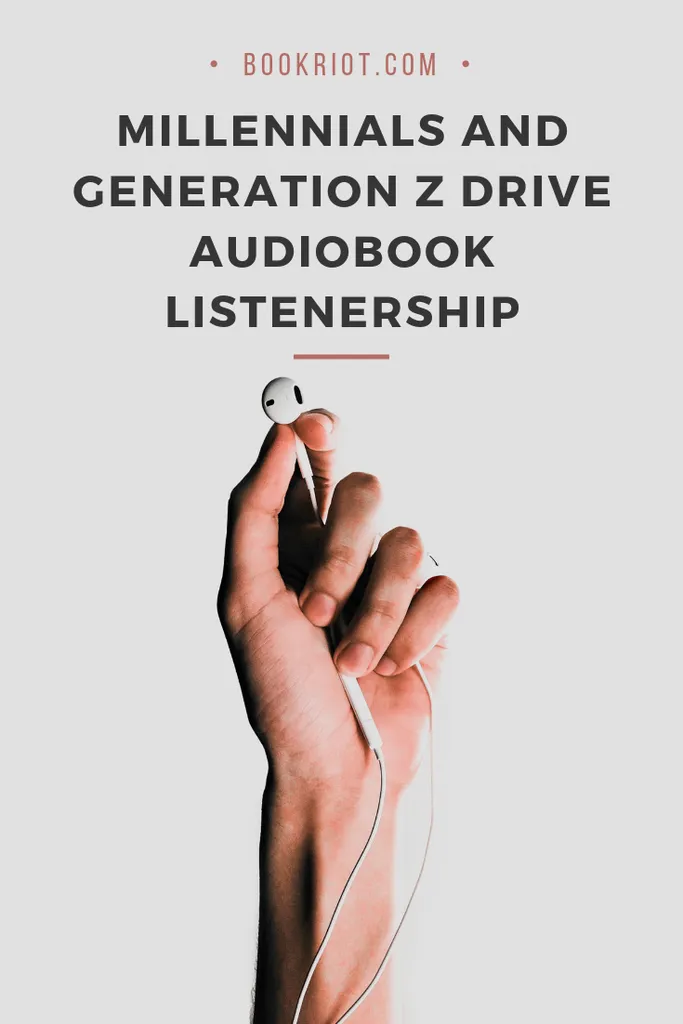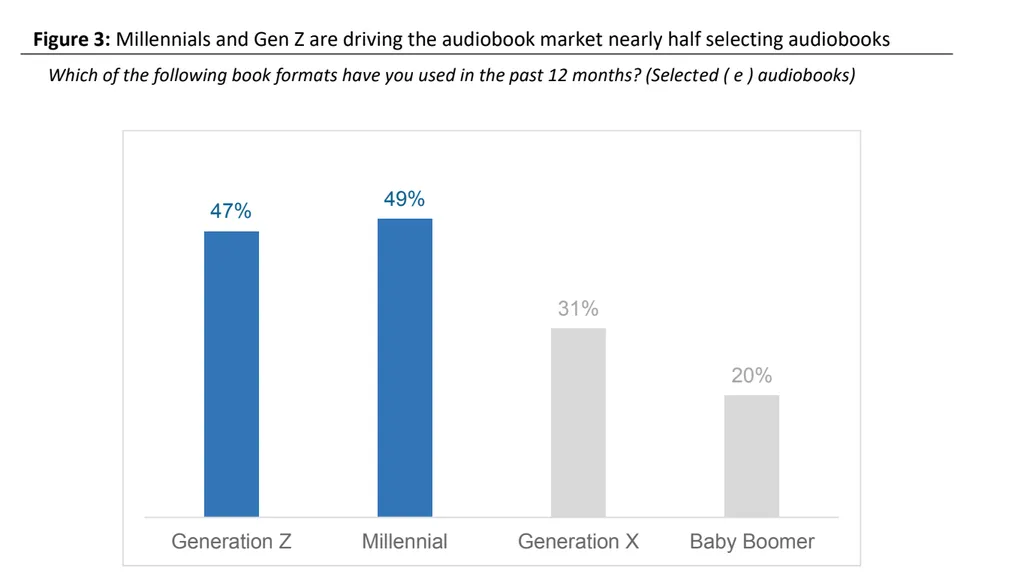
Millennials and Generation Z Drive Audiobook Listenership
“In an oversaturated new media market, one medium is tried and true – books. Contrary to popular belief, technology hasn’t hindered a good story. Rather, it has helped an increasingly busy society continue to consume books, in a world full of always-on distractions. Reading technology has given people the option to choose the format that can be seamlessly integrated into their traditional reading habits,” begins a new report from Rakuten OverDrive exploring the effects of technology on U.S. book consumption.
The report, released this week, highlighted the popularity of audiobooks as a tool for reading, particularly among adults. OverDrive surveyed over 730 adults in February of this year, diving into their reading lives and where and how technology has impacted it.
 For those working with books, the results are not surprising, but rather validate the reality of audiobooks continuing to be not only a growing market, but a way for many to enjoy reading while juggling many other tasks in their daily life. OverDrive reports that one in three adults listen to audiobooks, spending at least three hours a week listening. Almost a quarter of those who listen do so at seven or more hours a week.
Audiobook consumption is most common among younger adults, who tend to listen while taking part in other tasks. The ease and availability of audiobooks to be taken along via a personal device makes this a more common choice than print or ebooks for multitasking and reading.
Over half of audiobook listeners tune in while completing tasks around the house, including cooking and chores, and 40% tune into a book when exercising or driving. Still others (roughly 45%) use audiobooks as a means of passing time while waiting in lines, in doctor’s offices, and similar activities.
For those working with books, the results are not surprising, but rather validate the reality of audiobooks continuing to be not only a growing market, but a way for many to enjoy reading while juggling many other tasks in their daily life. OverDrive reports that one in three adults listen to audiobooks, spending at least three hours a week listening. Almost a quarter of those who listen do so at seven or more hours a week.
Audiobook consumption is most common among younger adults, who tend to listen while taking part in other tasks. The ease and availability of audiobooks to be taken along via a personal device makes this a more common choice than print or ebooks for multitasking and reading.
Over half of audiobook listeners tune in while completing tasks around the house, including cooking and chores, and 40% tune into a book when exercising or driving. Still others (roughly 45%) use audiobooks as a means of passing time while waiting in lines, in doctor’s offices, and similar activities.
 It comes as little surprise that Gen Z and Millennials are among the most likely to listen to books on audio, with 48% of audiobook consumers. Technology being such a constant part of their young lives and dominating their adulthood suggests that using personal devices to tap into more reading is only nature.
Baby Boomers and Gen X listeners make up only about a quarter of audiobook selectors.
Libraries have only helped make the use of audiobooks easier, as many listeners consider them a reliable source for acquiring new titles to read. The desire to support local libraries, as well as the ease and convenience of borrowing while on the go, were cited among reasons that 33% of audiobook listeners choose to borrow.
When do readers choose audio over print or digital reading? According to the report, 45% percent listen to relax or unwind, followed by those who listen while working on mindless tasks, passing time, or when they can’t find time for another format. This, of course, fits with the findings noted earlier, that ease and convenience of a personal device allows for multitasking.
Other responses express a desire for seeking a more immersive experience, as well as a desire to better comprehend the text. Likewise, audiobooks are an opportunity for sharing a reading experience with another person.
“With the broad adoption of the smartphone, tablets and AI assistants – it’s clear why audiobooks have grown in popularity in recent years. Through the rise of audiobooks, consumers have been reconnected with reading because of one major factor – its ease of use,” the report stated.
It comes as little surprise that Gen Z and Millennials are among the most likely to listen to books on audio, with 48% of audiobook consumers. Technology being such a constant part of their young lives and dominating their adulthood suggests that using personal devices to tap into more reading is only nature.
Baby Boomers and Gen X listeners make up only about a quarter of audiobook selectors.
Libraries have only helped make the use of audiobooks easier, as many listeners consider them a reliable source for acquiring new titles to read. The desire to support local libraries, as well as the ease and convenience of borrowing while on the go, were cited among reasons that 33% of audiobook listeners choose to borrow.
When do readers choose audio over print or digital reading? According to the report, 45% percent listen to relax or unwind, followed by those who listen while working on mindless tasks, passing time, or when they can’t find time for another format. This, of course, fits with the findings noted earlier, that ease and convenience of a personal device allows for multitasking.
Other responses express a desire for seeking a more immersive experience, as well as a desire to better comprehend the text. Likewise, audiobooks are an opportunity for sharing a reading experience with another person.
“With the broad adoption of the smartphone, tablets and AI assistants – it’s clear why audiobooks have grown in popularity in recent years. Through the rise of audiobooks, consumers have been reconnected with reading because of one major factor – its ease of use,” the report stated.
 For those working with books, the results are not surprising, but rather validate the reality of audiobooks continuing to be not only a growing market, but a way for many to enjoy reading while juggling many other tasks in their daily life. OverDrive reports that one in three adults listen to audiobooks, spending at least three hours a week listening. Almost a quarter of those who listen do so at seven or more hours a week.
Audiobook consumption is most common among younger adults, who tend to listen while taking part in other tasks. The ease and availability of audiobooks to be taken along via a personal device makes this a more common choice than print or ebooks for multitasking and reading.
Over half of audiobook listeners tune in while completing tasks around the house, including cooking and chores, and 40% tune into a book when exercising or driving. Still others (roughly 45%) use audiobooks as a means of passing time while waiting in lines, in doctor’s offices, and similar activities.
For those working with books, the results are not surprising, but rather validate the reality of audiobooks continuing to be not only a growing market, but a way for many to enjoy reading while juggling many other tasks in their daily life. OverDrive reports that one in three adults listen to audiobooks, spending at least three hours a week listening. Almost a quarter of those who listen do so at seven or more hours a week.
Audiobook consumption is most common among younger adults, who tend to listen while taking part in other tasks. The ease and availability of audiobooks to be taken along via a personal device makes this a more common choice than print or ebooks for multitasking and reading.
Over half of audiobook listeners tune in while completing tasks around the house, including cooking and chores, and 40% tune into a book when exercising or driving. Still others (roughly 45%) use audiobooks as a means of passing time while waiting in lines, in doctor’s offices, and similar activities.
 It comes as little surprise that Gen Z and Millennials are among the most likely to listen to books on audio, with 48% of audiobook consumers. Technology being such a constant part of their young lives and dominating their adulthood suggests that using personal devices to tap into more reading is only nature.
Baby Boomers and Gen X listeners make up only about a quarter of audiobook selectors.
Libraries have only helped make the use of audiobooks easier, as many listeners consider them a reliable source for acquiring new titles to read. The desire to support local libraries, as well as the ease and convenience of borrowing while on the go, were cited among reasons that 33% of audiobook listeners choose to borrow.
When do readers choose audio over print or digital reading? According to the report, 45% percent listen to relax or unwind, followed by those who listen while working on mindless tasks, passing time, or when they can’t find time for another format. This, of course, fits with the findings noted earlier, that ease and convenience of a personal device allows for multitasking.
Other responses express a desire for seeking a more immersive experience, as well as a desire to better comprehend the text. Likewise, audiobooks are an opportunity for sharing a reading experience with another person.
“With the broad adoption of the smartphone, tablets and AI assistants – it’s clear why audiobooks have grown in popularity in recent years. Through the rise of audiobooks, consumers have been reconnected with reading because of one major factor – its ease of use,” the report stated.
It comes as little surprise that Gen Z and Millennials are among the most likely to listen to books on audio, with 48% of audiobook consumers. Technology being such a constant part of their young lives and dominating their adulthood suggests that using personal devices to tap into more reading is only nature.
Baby Boomers and Gen X listeners make up only about a quarter of audiobook selectors.
Libraries have only helped make the use of audiobooks easier, as many listeners consider them a reliable source for acquiring new titles to read. The desire to support local libraries, as well as the ease and convenience of borrowing while on the go, were cited among reasons that 33% of audiobook listeners choose to borrow.
When do readers choose audio over print or digital reading? According to the report, 45% percent listen to relax or unwind, followed by those who listen while working on mindless tasks, passing time, or when they can’t find time for another format. This, of course, fits with the findings noted earlier, that ease and convenience of a personal device allows for multitasking.
Other responses express a desire for seeking a more immersive experience, as well as a desire to better comprehend the text. Likewise, audiobooks are an opportunity for sharing a reading experience with another person.
“With the broad adoption of the smartphone, tablets and AI assistants – it’s clear why audiobooks have grown in popularity in recent years. Through the rise of audiobooks, consumers have been reconnected with reading because of one major factor – its ease of use,” the report stated.










